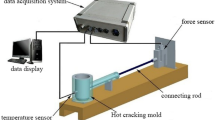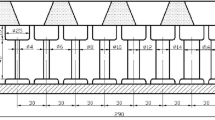Abstract
Mg–Zn–Ca alloy has a good development prospect in biomedical alloy. However, its development is restricted by large hot tearing susceptibility. Herein, the influence of Ca addition on the hot tearing susceptibility (HTS) of Mg-4Zn-xCa-0.3Zr (0.5, 1, 1.5, and 2 wt%) alloys has been studied by using thermal analysis and numerical simulation software, Procast. The “Clyne–Davies” hot tearing prediction model was improved, and Cracking Susceptibility Coefficient (CSC) was recalculated to highlight the physical significance of the model. The hot tearing zone was observed via optical microscopy and scanning electron microscopy, and the phase composition was analyzed with X-ray diffraction. The results of numerical simulations suggest that the Hot Tearing Indicator (HTI) tended to decrease with increase in Ca addition. However, the experimental results reveal that with the increase in Ca addition, the hot tearing susceptibility of the alloys first decreased with Ca addition up to 1.5 wt% and then displayed a slight increase with the addition up to 2.0 wt%. The SEM images and experimental results reveal that the thickness and ability to resist solidification shrinkage stress of the liquid membrane, quantity of the second phases, and feeding ability were all enhanced with the increase in Ca addition, thereby reducing the HTS of Mg-4Zn-XCa-0.3Zr alloys. When the Ca addition reached 2.0 wt%, the brittle calcium-containing phase forms at the grain boundary, which reduces the high-temperature strength of the matrix and the ability to resist the solidification shrinkage stress of the alloy, resulting in an increase in HTS. Therefore, when the Ca addition was 2.0 wt%, the simulation results were different from the experimental results.











Similar content being viewed by others
References
Ma. Ying, Z.M. Guo Yang, CJXu Zhang, Z.L. Lu, Effect of Ca on microstructure and corrosion properties of As-cast Mg-4Zn alloy. Trans. Mater. Heat Treat 36(1), 62–69 (2015)
Z. Liu, Y. Zhang, P.L. Mao et al., Effect of Ca on hot tearing susceptibility of Mg-Zn alloy. J. Shenyang Univ. Technol. 6, 624 (2013)
B.P. Zhang, Y. Wang, L. Geng et al., Effects of calcium on texture and mechanical properties of hot-extruded Mg-Zn-Ca alloys. Mater. Sci. Eng., A 539(2), 56 (2012)
H. Somekawa, T. Mukai, High strength and fracture toughness balance on the extruded Mg-Ca-Zn alloy. Mater. Sci. Eng., A 459(1), 366 (2007)
X.M. Zhang, Q.L. Zhu, T. Zhou, Effect of Ca on microstructure and properties of rapidly solidified Mg-6Zn alloy thin strip. Special Casting and Nonferrous Alloys 30(8), 772–775 (2010)
X.Y. Zhang, Microstructure And Properties Research of Mg-Zn-Ca Alloy Under the Action of Magnetic Field [D] (Harbin University of Science and Technology, Harbin, 2015)
Y.D. Yu, Q. Li, Diffusion bonding in superplastic ZK60 Magnesium Alloy. Mater. Sci. Forum 517, 227–230 (2005)
G. Zhu, Z. Wang, W. Qiu et al., Effect of yttrium on hot tearing susceptibility of Mg-6Zn-1Cu-0.6Zr alloys. Int. J. Metalcast. 14(1), 179–190 (2020). https://doi.org/10.1007/s40962-019-00352-x
Z. Wang, Y. Zhou, L. Zhou, Y.Z. Li, P.L. Mao, Z. Liu, F. Wang, Effect of Ca and Y on hot cracking behavior of Mg-1.5Zn alloy. Chin. J. Mater. Res. 31(8), 561–568 (2017)
K.Q. Qiu, S.W. Tao, Y. Re, J.H. You, Y.L. Ren, R.D. Li, Effect of Ca on hot cracking tendency of Mg-7Al-2Si alloy. Special Casting and Nonferrous Alloy 33(2), 186–190 (2013)
G. Cao, S. Kou, Hot cracking susceptibility of ternary Mg-Al-Ca alloys. Adv. Mater. Res. 59, 501–506 (2007)
F. Wang, H.K. Dong, Z. Wang et al., Hot cracking behavior of Mg-5Al-xCa Alloys. Acta Metall. Sin. 53(2), 219–222 (2017)
J. Fu, B.Y. Peng, J.G. Cao, Numerical Simulation of Material Forming Process [M] (Chemical Industry Press, Beijing, 2009)
L.L. Chen, CAD/CAE/CAM Technology Foundation for Material Processing [M] (Machinery Industry Press, Beijing, 2006)
J.Z. Zhu, J. Guo, M.T. Samonds, Numerical modeling of hot tearing formation in metal casting and its validations. Int. J. Numer. Meth. Eng. 87(1–5), 289–308 (2011)
Z. Wang, Y.D. Huang, A. Srinivasan et al., Experimental and numerical analysis of hot tearing susceptibility for Mg–Y alloys. Journal of Materials Science 49(1), 353–362 (2014)
T.W. Clyne, G.J. Davies, The effect of melt composition on solidification cracking of steel, with particular reference to continuous casting. Metall. Trans. B 13(2), 259–266 (1982)
T.W. Clyne, M. Wolf, W. Kurz, The effect of melt composition on solidification cracking of steel, with particular reference to continuous casting. Metall. Trans. B 13B, 259 (1982)
Z. Wang, Y.Z. Li, Z. Liu et al., Solidification path and hot tearing tendency of Mg-6Zn-xCu-0.6Zr alloys. Chin. J. Nonferrous Metals 028(007), 1309–1319 (2018)
D.H. Hou, S.M. Liang, R.S. Chen et al., Effects of Sb content on solidification pathways and grain size of AZ91 magnesium alloy. Acta Metallurgica Sinica (English Letters) 28(1), 115–121 (2015)
W.I. Pumphre, P.H. Jennings, A consideration of the nature of brittleness above the solidus in castings and welds on aluminum alloys. J. Jpn. Inst. Met. 75(4), 235–256 (1998)
Y.Q. Li, J.F. Wang, W.J. Gou, Electronic theoretical analysis of Sn for improving properties of Mg-Al alloy. Foundry 61(9), 995–997 (2012)
X D Du, F Wang, Z Wang, et al. Hot Tearing Susceptibility of AXJ530 Alloy Under Low-Frequency Alternating Magnetic Field. Acta Metallurgica Sinica (English Letters), 2020
Z. Liu, S.B. Zhang, P.L. Mao et al., Effects of Y on hot tearing susceptibility of Mg-Zn-Y-Zr alloys. Trans. Nonferrous Metals Soc. China 24(4), 907–914 (2014)
.J L Yang. Study on Microstructure and Mechanical Properties of Mg-Zn-Ca Cast Magnesium Alloy [D]. Shenyang University of Technology, 2016
J.C. Borland, Fundamentals of solidification cracking in welds. Welding Metal Fabr. 3, 99–107 (1979)
Q.C. Li, Foundations of Casting Formation Theory (Mechanical Industry Press, Beijing, 1982)
T.W. Clyne, G.J. Davies, A quantitative solidification cracking test for castings and an evaluation of cracking in Al-Mg alloys. British Foundryman 68, 238–244 (1975)
Y.S. Wang, Q.D. Wang, D.J. Wen et al., Hot cracking mechanism of alloy and its research progress. Special Casting and Nonferrous Alloy 2, 48–50 (2000)
H. Ding, H.Z. Fu, Z.Y. Liu et al., Solidification shrinkage compensation and hot cracking tendency of alloy. Acta Metall. Sin. 33(9), 921–926 (1997)
Acknowledgements
This work is supported by LiaoNing Revitalization Talents Program (No. XLYC1807021), Joint Research Fund Liaoning-Shenyang National Laboratory for Materials Science (2019JH3/30100014), Liaoning BaiQianWan Talents Program, Innovation Talent Program in Sciences and Technologies for Young and Middleaged Scientists of Shenyang (RC200414) and High level innovation team of Liaoning Province (XLYC1908006).
Author information
Authors and Affiliations
Corresponding author
Additional information
Publisher's Note
Springer Nature remains neutral with regard to jurisdictional claims in published maps and institutional affiliations.
Rights and permissions
About this article
Cite this article
Bai, S., Wang, F., Wang, Z. et al. Effect of Ca Content on Hot Tearing Susceptibility of Mg-4Zn-xCa-0.3Zr (x = 0.5, 1, 1.5, 2) Alloys. Inter Metalcast 15, 1298–1308 (2021). https://doi.org/10.1007/s40962-020-00553-9
Received:
Accepted:
Published:
Issue Date:
DOI: https://doi.org/10.1007/s40962-020-00553-9




